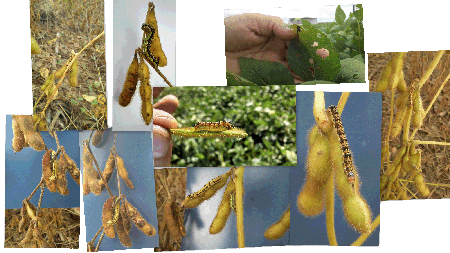 [ RNASeq transcripts ]
[ RNASeq transcripts ]
Helicoverpa armigera (cotton bollworm) is a species of insect-pest from Lepidoptera order distributed throughout almost all the globe. Actually, this pest can be considered an important pest, as in cotton and soybean fields at Australia, Brazil, China, India and Pakistan; in maize fields at Australia, and in vegetables fields in Europe. In its caterpillar stage, H. armigera is extremely aggressive, due to its polyphagous habit, when it can feed on more than 100 plant species, wild or cultivated. Where this pest occurs, there are serious difficulties in controlling it, especially since it naturally tolerates many insecticides that control other insect species. On the other hand, several local populations develop resistance to many insecticides used on the crops, with great speed. The presence of H. armigera populations was first reported in Brazil in 2013, more specifically in the states of Goiás, Mato Grosso, Bahia and Paraná. Before that, it was considered a quarantine pest in the country. A few months later, the presence of this pest was registered also in Paraguay and Argentina. Currently, this set of characteristics places H. armigera as one of the most important and feared insect-pest in Brazilian agriculture, since it presents risks to more than 50 million hectares of planted area, and possibly losses of billions of dollars, either due to increase the use of insecticides or to improve losses imposed on important crops, such as soybean (Glycine max), cotton (Gossypium sp.), maize (Zea mays) and other cereals, as well as tobacco, potatoes (Solanum tuberosum), tomato (Solanum lycopersicum), several vegetable specie, among others.
Beside that, H. armigera presents in its life cycle the phases of egg, caterpillar, pulp and adult. Its eggs have an incubation period of about 3 days, and may have a yellowish-white color after deposition on the substrate and become brown next to the caterpillar hatching. The oviposition is nocturnal, where in each laying, 700 to 4,000 eggs can be laid, isolated in the plants. On the other hand, H. armigera caterpillar stage has about five or six instars, which can last around 21-26 days, depending of the environment. In the first and second instars, the caterpillars are not very mobile in the plant and have a color ranging from yellowish-white to reddish-brown. In these phases, H. armigera caterpillar feed on the tenderest parts of the plants, where they can produce a type of “web” or even form a small cocoon. With the growth of the caterpillars and reaching new instars, the caterpillar’s coloration can change, varying from straw yellow to green, with brownish stripes on the side. Following, the pulp phase lasts about 10 to 14 days. Finally, the female's adult survival period is 11.7 days and the male is 9.2 days. Female moths can lay eggs in isolation or grouped eggs on leaves. Females have a more yellowish color and males are grayish. It is in adulthood that H. armigera has great dispersion capacity in the production fields.
Even though H. armigera has triggered economic losses and an increased use of insecticides in Brazil, this pest can be managed with the correct adoption of integrated pest management, especially with the use of biotechnological assets, such as Bt plants and RNA interference (RNAi)-mediated gene silencing technology. In order to develop new ecofriendly technologies applied to control of H. armigera, the Plant-Pest Molecular Interaction Laboratory (LIMPP), together with the Bioinformatics Laboratory, both located at Embrapa Genetic Resources & Biotechnology (Brasilia-Brazil) and supported by PlantStress Biotech National Institute of Science & Technology (INCT), focused on observing the differences in cotton bollworm development when fed on two host crops: cotton (Gossypium hirsutum) and tobacco (Nicotiana benthamiana). Initially, it was observed the development of caterpillar on each host plant. Feed bioassay results suggested that most H. armigera caterpillars failed to complete their life cycle on N. benthamiana and were susceptible to the deleterious effects of feeding on these plants. Here is presented the RNA-Seq (Illumina Platform) data of H. armigera caterpillars fed with both cotton and tobacco.
